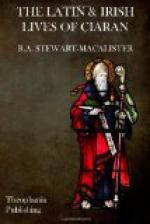The second stanza is misplaced, and should properly have been inserted in the following paragraph. Its metre is ae freslige—seven-syllable lines in a quatrain, rhyming abab: a being trisyllabic, b dissyllabic rhymes. The stanza is obscure and probably corrupt; so far as it can be rendered at all, the literal translation is: “He healed the steed of Oengus / when he was in a swathe, in a cradle // there was given ... / from God this miracle to Ciaran.”
III. HOW CIARAN RAISED THE STEED OF OENGUS FROM DEATH (LA, LB, LC, VG)
The Four Versions.—This incident is told in all four lives, and it is instructive to note the differences of detail which they display. In LA Oengus goes to fetch Ciaran, after consulting with his friends. In LB he sends for him. In LC he goes to him, and in VG Ciaran comes without being fetched. The stanza interpolated in the preceding section of VG introduces us to another variant of the tradition, in which Ciaran was a swaddled infant when the miracle was wrought. In LB the incident is given a homiletic turn, by being told to illustrate the saint’s care for animals.
Parallels.—A similar but not identical miracle is attributed to Saint Patrick (VTP, 228; LL, 565). Here the saint resuscitates horses with holy water; but in this case the saint’s own curse had originally caused the horses’ deaths, because they grazed in his churchyard. Saint Lasrian also restored a horse to life (CS, 796).
Tir na Gabrai ("the land of the horse”) is unknown, though it presumably was near Raith Cremthainn. The story was probably told to account for the name of the field. It has been noticed that the Latin Lives are less rich in details as to names of places and people than the Irish Life. This is an indication of a later tradition, when the recollection of names had become vague, or, rather, when names which had been of interest to their contemporaries had ceased to rouse such feelings.
IV. HOW CIARAN TURNED WATER INTO HONEY (LA, LB, LC, VG)
One of the numerous imitations of the story of the
Miracle of Cana.
Compare incident XLIV. An identical story is
told of Saint Patrick
(LL, 108). Note the variety of reasons given
for sending the honey to
Iustus.
V. HOW CIARAN WAS DELIVERED FROM A HOUND (LA, LB, LC, VG)
Parallels.—The same story is told of Saint Patrick, in Colgan’s Tertia Vita, cap. xxxi, Septima Vita, I, cap. xlvii. Patrick likewise quoted the verse Ne tradas bestiis animus confitentes tibi (Ps. lxiv, [Vulgate lxiii] 19).
The Fate of the Hound.—This varies in the different versions. In the Patrick story just quoted it was struck immovable, as a stone. In LA it thrusts its head in circo uituli, which I have rendered conjecturally as the context seems to require, but I can find no information as to the exact nature of this adjunct to the cattle-stall. Du Cange gives arcus sellae equestris as one of the meanings of circus.




